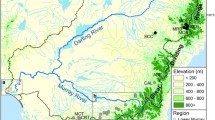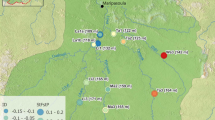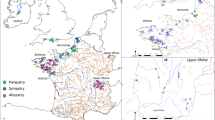Abstract
Conserving biodiversity in an era of rapid climate change requires understanding the mechanisms that influence dispersal, gene flow and, ultimately, species persistence. This information is becoming critical for conserving key species in rapidly warming places such as the Arctic. Arctic freshwater fish not only face warmer conditions, but also the drying of tundra streams due to climate change. Here, we examined population structure, gene flow, and the influence of landscape features on the neutral genetic variation of the Arctic grayling on Alaska’s North Slope. We estimated the number of genetically distinct clusters and determined effective population sizes for and patterns of gene flow among geographic regions. We predicted that river distance, river drying, distance to the coast, and elevational gradient would influence genetic differentiation for Arctic grayling. Bayesian clustering and discriminant analysis of principal components found support for five or six genetic clusters roughly corresponding to downstream and headwater subwatersheds. Estimates of gene flow revealed asymmetric downstream bias. River distance and river dry zones were significantly associated with increasing genetic differentiation among sampling locations despite this species' high dispersal capability and the temporary nature of dry zones. Isolation and downstream-biased dispersal could contribute to high levels of inter-population genetic variation among the headwaters of the North Slope Arctic grayling metapopulation, which might be particularly important for species conservation during rapid climate change. More generally, small, isolated populations might drive particular alleles to higher frequencies due to selection or drift, thus promoting the genetic potential for rapid evolutionary changes under future climate change.



Similar content being viewed by others
Data availability
All data will be deposited in a public data repository on publication.
References
ACIA (2005) Arctic Climate Impact Assessment. ACIA Overview report. Cambridge University Press
Altermatt F, Ebert D (2010) Populations in small, ephemeral habitat patches may drive dynamics in a Daphnia magna metapopulation. Ecology 91:2975–2982
Beauchamp DA (1990) Movements, habitat use, and spawning strategies of arctic grayling in a subalpine lake tributary. Northwest Sci 64:195–207
Bergerot B, Hugueny B, Belliard J (2015) Relating life-history traits, environmental constraints and local extinctions in river fish. Freshw Biol 60:1279–1291. https://doi.org/10.1111/fwb.12561
Betts ED, Kane DL (2015) Linking north slope of Alaska climate, hydrology, and fish migration. Hydrol Res. https://doi.org/10.2166/nh.2014.031
Blair SD, Matheson D, He Y, Goss GG (2016) Reduced salinity tolerance in the Arctic grayling (Thymallus arcticus) is associated with rapid development of a gill interlamellar cell mass: implications of high-saline spills on native freshwater salmonids. Conserv Physiol 4(1):cow010
Buzby KM, Deegan LA (2004) Long-term survival of adult Arctic grayling (Thymallus arcticus) in the Kuparuk river, Alaska. Can J Fish Aquat Sci 61:1954–1964
Campbell Grant EH, Lowe WH, Fagan WF (2007) Living in the branches: population dynamics and ecological processes in dendritic networks. Ecol Lett. https://doi.org/10.1111/j.1461-0248.2006.01007.x
Diggs MD, Ardren WR (2008) Characterization of 12 highly variable tetranucleotide microsatellite loci for Arctic grayling (Thymallus arcticus) and cross amplification in other Thymallus species. Mol Ecol Resour. https://doi.org/10.1111/j.1755-0998.2007.02081.x
Do C, Waples RS, Peel D, Macbeth GM, Tillett BJ, Ovenden JR (2014) NeEstimator v2: Re-implementation of software for the estimation of contemporary effective population size (Ne) from genetic data. Mol Ecol Resour. https://doi.org/10.1111/1755-0998.12157
Earl DA, VonHoldt BM (2011) STRUCTURE HARVESTER: a website and program for visualizing STRUCTURE output and implementing the Evanno method. Conserv Genet Resour 4(2):359–361. https://doi.org/10.1007/s12686-011-9548-7
England PR, Cornuet J-M, Berthier P, Tallmon DA, Luikart G (2006) Estimating effective population size from linkage disequilibrium: severe bias in small samples. Conserv Genet 7(2):303–308. https://doi.org/10.1007/s10592-005-9103-8
ESRI (2013) ArcGIS desktop: release 10.2. Environmental Systems Research Institute, Redlands, CA
Evanno G, Regnaut S, Goudet J (2005) Detecting the number of clusters of individuals using the software STRUCTURE: a simulation study. Mol Ecol. https://doi.org/10.1111/j.1365-294X.2005.02553.x
Excoffier L, Lischer HEL (2010) Arlequin suite ver 3.5: a new series of programs to perform population genetics analyses under Linux and Windows. Mol Ecol Resour. https://doi.org/10.1111/j.1755-0998.2010.02847.x
Fagan W (2002) Connectivity, fragmentation, and extinction risk in dendritic metapopulations. Ecology 83:3243–3249
Fagan WF, Unmack PJ, Burgess C, Minckley WL (2007) Rarity, fragmentation, and extinction risk in desert fishes. Ecology. https://doi.org/10.1890/0012-9658(2002)083%5B3243:CFAERI%5D2.0.CO%3B2
Faubet P, Waples R, Gaggiotti O (2007) Evaluating the performance of a multilocus Bayesian method for the estimation of migration rates. Mol Ecol 16:1149–1166. https://doi.org/10.1111/j.1365-294X.2007.03218.x
Fausch KD, Torgersen CE, Baxter CV, Li HW (2002) Landscapes to riverscapes: bridging the gap between research and conservation of stream fishes. Bioscience 52:483–498
Fitzpatrick SW, Crockett H, Funk WC (2014) Water availability strongly impacts population genetic patterns of an imperiled Great Plains endemic fish. Conserv Genet. https://doi.org/10.1007/s10592-014-0577-0
Funk WC, McKay JK, Hohenlohe PA, Allendorf FW (2012) Harnessing genomics for delineating conservation units. Trends Ecol Evol. https://doi.org/10.1016/j.tree.2012.05.012
Galpern P, Peres-Neto P, Polfus J, Manseau M (2014) MEMGENE: spatial pattern detection in genetic distance data. Methods Ecol Evol. https://doi.org/10.1111/2041-210X.12240
Gilk SE, Wang IA, Hoover CL, Smoker WW, Taylor SG, Gray AK, Gharrett AJ (2004) Outbreeding depression in hybrids between spatially separated pink salmon, onchorhynchus gorbuscha, populations: marine survival, homing ability, and variability in family size. Environ Biol Fishes 69:287–297. https://doi.org/10.1023/B:EBFI.0000022888.28218.c1
Guo SW, Thompson EA (1992) Performing the exact test of Hardy-Weinberg proportion for multiple alleles. Biometrics. https://doi.org/10.2307/2532296
Hamilton TD (2003) Glacial geology of the toolik lake and upper kuparuk river regions (No. 26). In D Walker (ed) Biological papers of the University of Alaska, Fairbanks, Alaska
Harvey BC (1999) Susceptibility of young-of-the-year fishes to downstream displacement by flooding. Trans Am Fish Soc. https://doi.org/10.1577/1548-8659(1987)116%3c851:SOYFTD%3e2.0.CO;2
Hinzman LD, Bettez ND, Bolton WR et al (2005) Evidence and implications of recent climate change in Northern Alaska and other Arctic regions. Climatic Change. https://doi.org/10.1007/s10584-005-5352-2
Hoffmann AA, Sgrò CM (2011) Climate change and evolutionary adaptation. Nature. https://doi.org/10.1038/nature09670
Hopken MW, Douglas MR, Douglas ME (2013) Stream hierarchy defines riverscape genetics of a North American desert fish. Mol Ecol. https://doi.org/10.1111/mec.12156
IPCC (2013) Climate change 2013: the physical science basis. IPCC, Geneva, Switzerland
Jakobsson M, Rosenberg NA (2007) CLUMPP: a cluster matching and permutation program for dealing with label switching and multimodality in analysis of population structure. Bioinformatics. https://doi.org/10.1093/bioinformatics/btm233
Jenkins DG, Carey M, Czerniewska J, Fletcher J, Hether T, Jones A, Knight S, Knox J, Long T, Mannino M, McGuire M, Riffle A, Segelsky S, Shappell L, Sterner A, Strickler T, Rursi R (2010) A meta-analysis of isolation by distance: relic or reference standard for landscape genetics? Ecography 33:315–320. https://doi.org/10.1111/j.1600-0587.2010.06285.x
Jombart T, Devillard S, Balloux F (2010) Discriminant analysis of principal components: a new method for the analysis of genetically structured populations. BMC Genetics. http://www.biomedcentral.com/1471-2156/11/94.
Junge C, Museth J, Hindar K, Kraabøl M, Vøllestad LA (2014) Assessing the consequences of habitat fragmentation for two migratory salmonid fishes. Aquat Conserv. https://doi.org/10.1002/aqc.2391
Junker J, Peter A, Wagner CE, Mwaiko S, Germann B, Seehausen O, Keller I (2012) River fragmentation increases localized population genetic structure and enhances asymmetry of dispersal in bullhead (Cottus gobio). Conserv Genet. https://doi.org/10.1007/s10592-011-0306-x
Kalinowski ST (2005) Hp-Rare 1.0: a computer program for performing rarefaction on measures of allelic richness. Mol Ecol Notes. https://doi.org/10.1111/j.1471-8286.2004.00845.x
Kamvar ZN, Tabima JF, Grünwald NJ (2014) Poppr: an R package for genetic analysis of populations with clonal, partially clonal, and/or sexual reproduction. PeerJ 2:e281. https://doi.org/10.7717/peerj.281
Kane DL, Gieck RE, Kitover DC, Hinzman LD, McNamara JP, Yang D (2004) Hydrologic cycles on the North Slope of Alaska. In: Kane DL, Yang D (eds) Northern research basins water balance. IAHS Press, Wallingford, UK, pp 224–236
Kanno Y, Vokoun JC, Letcher BH (2011) Fine-scale population structure and riverscape genetics of brook trout (Salvelinus fontinalis) distributed continuously along headwater channel networks. Mol Ecol. https://doi.org/10.1111/j.1365-294X.2011.05210.x
Kelson SJ, Kapuscinski AR, Timmins D, Ardren WR (2015) Fine-scale genetic structure of brook trout in a dendritic stream network. Conserv Genet. https://doi.org/10.1007/s10592-014-0637-5
Kimura M, Weiss GH (1964) The stepping stone model of population structure and the decrease of genetic correlation with distance. Genetics. https://doi.org/10.1093/oxfordjournals.molbev.a025590
Labonne J, Ravigne V, Parisi B, Gaucherel C (2008) Linking dendritic network structures to population demogenetics: the downside of connectivity. Oikos. https://doi.org/10.1111/j.2008.0030-1299.16976.x
Lammers RB, Shiklomanov AI, Vorosmarty CJ, Fekete BM, Peterson BJ (2001) Assessment of contemporary Arctic river runoff based on observational discharge records. J Geophys Res 106:3321–2224. https://doi.org/10.1029/2000JD900444
Li Y, Liu J (2018) Structure selector: a web-based software to select and visualize the optimal number of clusters using multiple methods. Mol Ecol Res 18(1):176–177. https://doi.org/10.1111/1755-0998.12719
Lowe WH, Likens GE, McPeek MA, Buso DC (2006) Linking direct and indirect data on dispersal: Isolation by slope in a headwater stream salamander. Ecology 87(2):334–339. https://doi.org/10.1890/05-0232
Martin PD, Jenkins JL, Adams FJ, et al (2009) Wildlife response to environmental arctic change: predicting future habitats of Arctic Alaska. Report of the wildlife response to environmental arctic change (WildREACH): predicting future habitats of Arctic Alaska Workshop, Fairbanks, Alaska
Manel S, Holderegger R (2013) Ten years of landscape genetics. Trends Ecol Evol. https://doi.org/10.1016/j.tree.2013.05.012
Manel S, Schwartz MK, Luikart G, Taberlet P (2003) Landscape genetics: combining landscape ecology and population genetics. Trends Ecol Evol 18:189–197
Maria ALP, Irene K, Anja Marie W, Christopher TR (2012) How river structure and biological traits influence gene flow: a population genetic study of two stream invertebrates with differing dispersal abilities. Freshw Biol. https://doi.org/10.1111/j.1365-2427.2012.02758.x
Meeuwig MH, Guy CS, Kalinowski ST, Fredenberg WA (2010) Landscape influences on genetic differentiation among bull trout populations in a stream-lake network. Mol Ecol. https://doi.org/10.1111/j.1365-294X.2010.04655.x
Meffe GK, Vrijenhoek RC (1988) Conservation genetics in the management of desert fishes. Conserv Biol 2(2):157–169. https://doi.org/10.1111/j.1523-1739.1988.tb00167.x
Meirmans PG (2014) Nonconvergence in Bayesian estmation of migration rates. Mol Ecol Res 14(4):726–733. https://doi.org/10.1111/1755-0998.12216
Meirmans PG, Van Tienderen PH (2004) GENOTYPE and GENODIVE: two programs for the analysis of genetic diversity of asexual organisms. Mol Ecol Notes 4:792–794
Morrissey MB, de Kerckhove DT (2009) The maintenance of genetic variation due to asymmetric gene flow in dendritic metapopulations. Am Nat. https://doi.org/10.1086/599011
Mossop KD, Adams M, Unmack PJ, Smith Date KL, Wong BBM, Chapple DG (2015) Dispersal in the desert: ephemeral water drives connectivity and phylogeography of an arid-adapted fish. J Biogeogr. https://doi.org/10.1111/jbi.12596
Nei M, Li W (1973) Linkage disequilibrium in subdivided populations. Genetics 75(1):213–219
Nei M, Maruyama T, Chakraborty R (1975) The bottleneck effect and genetic variability in populations. Evolution. http://www.jstor.org/stable/2407137.
Nomura T (2008) Estimation of effective number of breeders from molecular coancestry of single cohort sample. Evol Appl. https://doi.org/10.1111/j.1752-4571.2008.00015.x
Northcote TG (1995) Comparative biology and management of Arctic and European grayling (Salmonidae, Thymallus). Rev Fish Biol Fish 5(2):141–194. https://doi.org/10.1007/bf00179755
Oksanen J, Blanchet FG, Kindt R et al (2013) Vegan: community ecology package. SAGE Publications Inc., California. https://doi.org/10.4135/9781412971874.n145
Opdam P, Wascher D (2004) Climate change meets habitat fragmentation: linking landscape and biogeographical scale levels in research and conservation. Biol Cons. https://doi.org/10.1016/j.biocon.2003.12.008
Ozerov MY, Veselov AE, Lumme J, Primmer CR, Moran P (2012) “Riverscape” genetics: river characteristics influence the genetic structure and diversity of anadromous and freshwater Atlantic salmon (Salmo salar) populations in northwest Russia. Can J Fish Aquat Sci. https://doi.org/10.1139/f2012-114
Parkinson D, Philippart JC, Baras E (1999) A preliminary investigation of spawning migrations of grayling in a small stream as determined by radio-tracking. J Fish Biol 55:172–182
Parmesan C (2006) Ecological and evolutionary responses to recent climate change. Annu Rev Ecol Evol Syst 37:637–669
Perkin JS, Gido KB, Costigan KH, Daniels MD, Johnson ER (2015) Fragmentation and drying ratchet down Great Plains stream fish diversity. Aquat Conserv Marine Freshw Ecosyst. https://doi.org/10.1002/aqc.2501
Peterson DP, Ardren WR (2009) Ancestry, population structure, and conservation genetics of Arctic grayling (Thymallus arcticus) in the upper Missouri river, USA. Can J Fish Aquat Sci. https://doi.org/10.1139/F09-113
Peterson EE, Ver Hoef JM (2014) STARS: an ArcGIS toolset used to calculate the statistical models to stream network data. J Stat Softw 56:1–17
Poissant J, Knight TW, Ferguson MM (2005) Nonequilibrium conditions following landscape rearrangement: the relative contribution of past and current hydrological landscapes on the genetic structure of a stream-dwelling fish. Mol Ecol. https://doi.org/10.1111/j.1365-294X.2005.02500.x
Primmer CR, Veselov AJ, Zubchenko A, Poututkin A, Bakhmet I, Koskinen MT (2006) Isolation by distance within a river system: genetic population structuring of Atlantic salmon, Salmo salar, in tributaries of the Varzuga river in northwest Russia. Mol Ecol. https://doi.org/10.1111/j.1365-294X.2005.02844.x
Pritchard J, Stephens M, Donnelly P (2000) Inference of population structure using multilocus genotype data. Genetics. http://www.genetics.org/cgi/content/abstract/155/2/945.
Puechmaille SJ (2016) The program structure does not reliably recover the correct population structure when sampling is uneven: subsampling and new estimators alleviate the problem. Mol Ecol Resour 16:608–627
Rambaut A, Drummond AJ, Suchard M (2003) Tracer v1.6: MCMC trace analysis package. Institute of Evolutionary Biology, Department of Computer Science. University of Edinburgh, Edinburgh
Rannala B (2007) BayesAss edition 3.0 user’s manual. Department of Evolution and Ecology, University of California, Davis, CA
Redenbach Z, Taylor EB (1999) Zoogeographical implications of variation in mitochondrial DNA of Artic grayling (Thymallus arcticus). Mol Ecol 8:23–35
Reilly JR, Paszkowski CA, Coltman DW (2014) Population genetics of Arctic grayling distributed across large, unobstructed river systems. Trans Am Fish Soc. https://doi.org/10.1080/00028487.2014.886620
Reist JD, Wrona FJ, Prowse TD, Power M, Dempson JB, King JR, Beamish RJ (2006) An overview of effects of climate change on selected arctic freshwater and anadromous fishes. Ambio 35:381–387
Richardson JL (2012) Divergent landscape effects on population connectivity in two co-occurring amphibian species. Mol Ecol 21:4437–4451
Richardson JL, Urban MC, Bolnick DI, Skelly DK (2014) Microgeographic adaptation and the spatial scale of evolution. Trends Ecol Evol. https://doi.org/10.1016/j.tree.2014.01.002
Rieman BE, Dunham JB (2000) Metapopulations and salmonids: a synthesis of life history patterns and empirical observations. Ecol Freshw Fish. https://doi.org/10.1034/j.1600-0633.2000.90106.x
Roberts JH, Angermeier PL, Hallerman EM (2013) Distance, dams and drift: what structures populations of an endangered, benthic stream fish? Freshw Biol. https://doi.org/10.1111/fwb.12190
Rosenberg NA (2003) Distruct: a program for the graphical display of population structure. Mol Ecol Notes. https://doi.org/10.1046/j.1471-8286.2003.00566.x
Rousset F (2008) GENEPOP’007: a complete re-implementation of the GENPOP software for Windows and Linux. Mol Ecol Resour. https://doi.org/10.1111/j.1471-8286.2007.01931.x
Scheffers BR, De Meester L, Bridge TCL, Hoffmann AA, Pandolfi JM, Corlett RT, Butchart SHM, Pearce-Kelly P, Kovacs KM, Dudgeon D, Pacifici M, Rondinini C, Foden WB, Martin TG, Mora C, Bickford D, Watson JEM (2016) The broad footprint of climate change from genes to biomes to people. Science 354:aaf7671
Schloss CA, Nuñez TA, Lawler JJ (2012) Dispersal will limit ability of mammals to track climate change in the Western Hemisphere. Proc Natl Acad Sci. https://doi.org/10.1073/pnas.1116791109
SDMI (2013) Alaska Mapped Statewide Digital Mapping (SDMI). http://www.alaskamapped.org/. Accessed 1 Jan 2014
Stamford MD, Taylor EB (2004) Phylogeographical lineages of Arctic grayling (Thymallus arcticus) in North America: divergence, origins and affinities with Eurasian Thymallus. Mol Ecol. https://doi.org/10.1111/j.1365-294X.2004.02174.x
Stamford MD, Taylor EB (2005) Population subdivision and genetic signatures of demographic changes in Arctic grayling (Thymallus arcticus ) from an impounded watershed. Can J Fish Aquat Sci. https://doi.org/10.1139/f05-156
Steed AC (2007) Population viability of Arctic grayling (Thymallus arcticus) in the Gibbon River. Montana State University, Yellowstone National Park
Storfer A, Murphy MA, Spear SF, Holderegger R, Waits LP (2010) Landscape genetics: where are we now? Mol Ecol. https://doi.org/10.1111/j.1365-294X.2010.04691.x
Urban MC, Zarnetske PL, Skelly DK (2013) Moving forward: dispersal and species interactions determine biotic responses to climate change. Ann N Y Acad Sci. https://doi.org/10.1111/nyas.12184
Urban MC, Bocedi G, Hendry AP et al (2016) Improving the forecast for biodiversity under climate change. Science. https://doi.org/10.1126/science.aad8466
USGS (2014) US geological survey. http://nhd.usgs.gov/. Accessed 1 Jan 2014
Vähä JP, Erkinaro J, Niemelä E, Primmer CR (2007) Life-history and habitat features influence the within-river genetic structure of Atlantic salmon. Mol Ecol. https://doi.org/10.1111/j.1365-294X.2007.03329.x
Van Leeuwen CHA, Dokk T, Haugen TO, Kiffney PM, Museth J (2017) Small larvae in large rivers: observations on downstream mofement of European grayling Thymallus thymallus during early life stages. J Fish Biol 90(6):2412–2424. https://doi.org/10.1111/jfb.13326
Van Oosterhout C, Hutchinson WF, Wills DPM, Shipley P (2004) MICRO-CHECKER: software for identifying and correcting genotyping errors in microsatellite data. Mol Ecol Notes. https://doi.org/10.1111/j.1471-8286.2004.00684.x
Wahlund S (1928) Zusammensetzung von populationen und korrelationserscheinungen vom standpunkt der vererbungslehre aus betrachtet. Hereditas. https://doi.org/10.1111/j.1601-5223.1928.tb02483.x
Waples RS, Do C (2010) Linkage disequilibrium estimates of contemporary Ne using highly variable genetic markers: a largely untapped resource for applied conservation and evolution. Evol Appl. https://doi.org/10.1111/j.1752-4571.2009.00104.x
Waples RS, Antao T, Luikart G (2014) Effects of overlapping generations on linkage disequilibrium estimates of effective population size. Genetics. https://doi.org/10.1534/genetics.114.164822
West RL, Smith MW, Barber WE, Reynolds JB, Hop H (1992) Autumn migration and overwintering of Arctic grayling in coastal streams of the Arctic national wildlife refuge. Transactions of the American Fisheries Society, Alaska. https://doi.org/10.1577/1548-8659(1992)121%3c0709:AMAOOA%3e2.3.CO;2
Wilson GA, Rannala B (2003) Bayesian inference of recent migration rates using multilocus genotypes. Genetics. http://www.genetics.org/cgi/content/abstract/163/3/1177.
Whiteley AR, Spruell P, Rieman BE, Allendorf FW (2006) Fine-scale genetic structure of bull trout at the southern limit of their distribution. Trans Am Fish Soc. https://doi.org/10.1577/T05-166.1
Whiteley AR, Hastings K, Wenburg JK, Frissell CA, Martin JC, Allendorf FW (2010) Genetic variation and effective population size in isolated populations of coastal cutthroat trout. Conserv Genet. https://doi.org/10.1007/s10592-010-0083-y
Whitlock MC (2011) G’ST and D do not replace FST. Mol Ecol. https://doi.org/10.1111/j.1365-294X.2010.04996.x
Acknowledgements
Research was funded by National Science Foundation Award PLR-1417754. MCU was also supported by the Center of Biological Risk and Arden Chair in Ecology and Evolutionary Biology, and HEG was supported by the US Environmental Protection Agency (EPA) STAR fellowship (EPA STAR F91745901).
Funding
Provided by NSF award PLR-1417754 and EPA STAR FP91745901.
Author information
Authors and Affiliations
Corresponding author
Ethics declarations
Conflict of interest
Authors declare that they have no conflicts of interest.
Ethical approval
Research was performed under IACUC protocol 17–18.
Consent for publication
All authors have given consent for publication.
Additional information
Publisher's Note
Springer Nature remains neutral with regard to jurisdictional claims in published maps and institutional affiliations.
Supplementary Information
Below is the link to the electronic supplementary material.
Rights and permissions
About this article
Cite this article
Golden, H.E., Holsinger, K.E., Deegan, L.A. et al. River drying influences genetic variation and population structure in an Arctic freshwater fish. Conserv Genet 22, 369–382 (2021). https://doi.org/10.1007/s10592-021-01339-0
Received:
Accepted:
Published:
Issue Date:
DOI: https://doi.org/10.1007/s10592-021-01339-0




